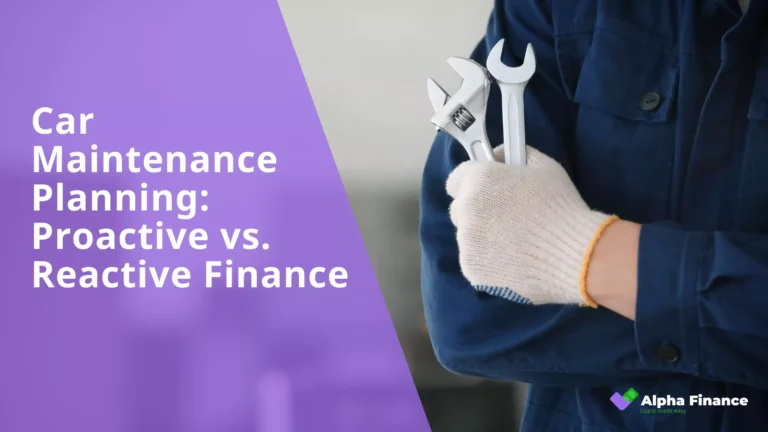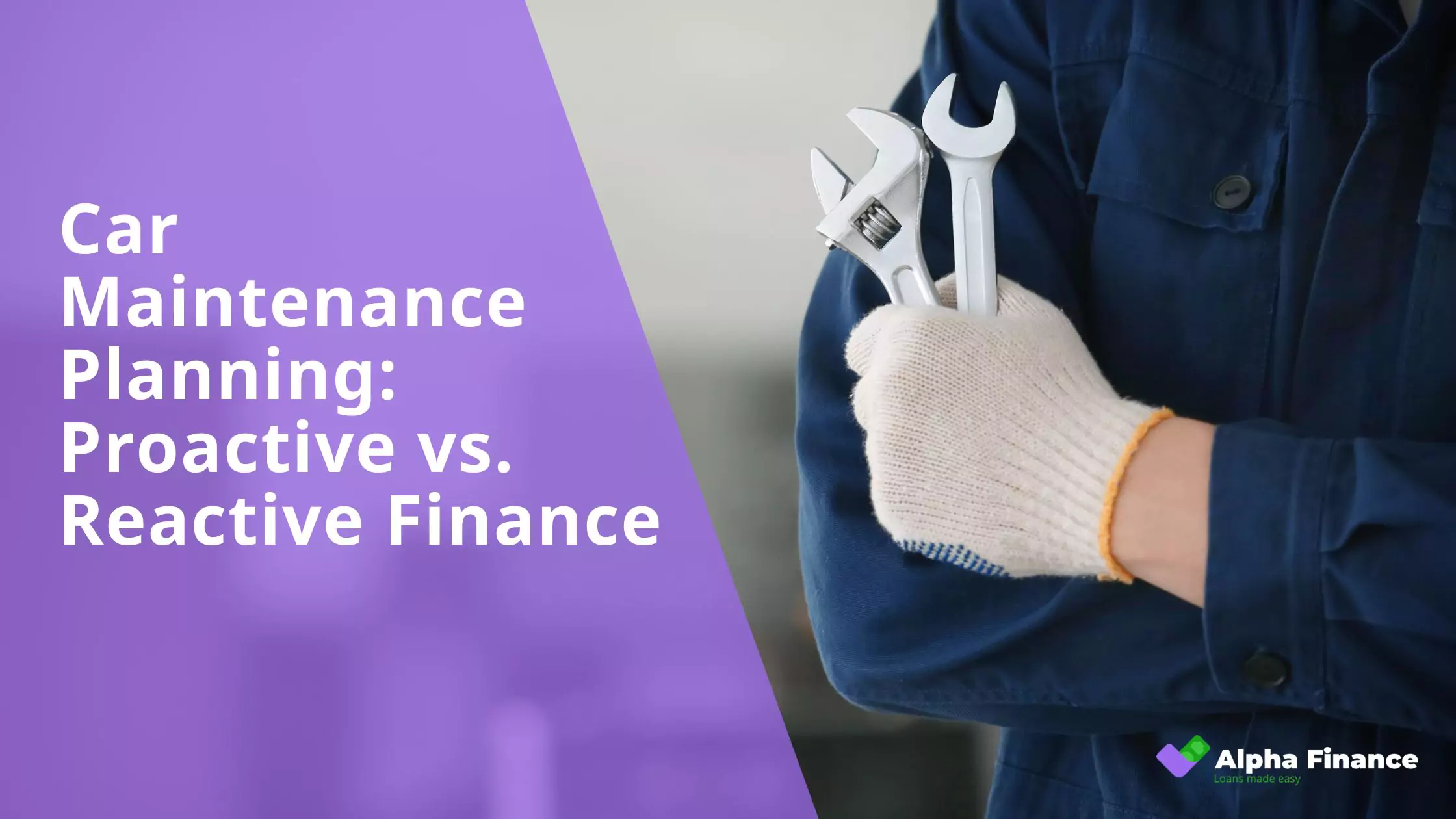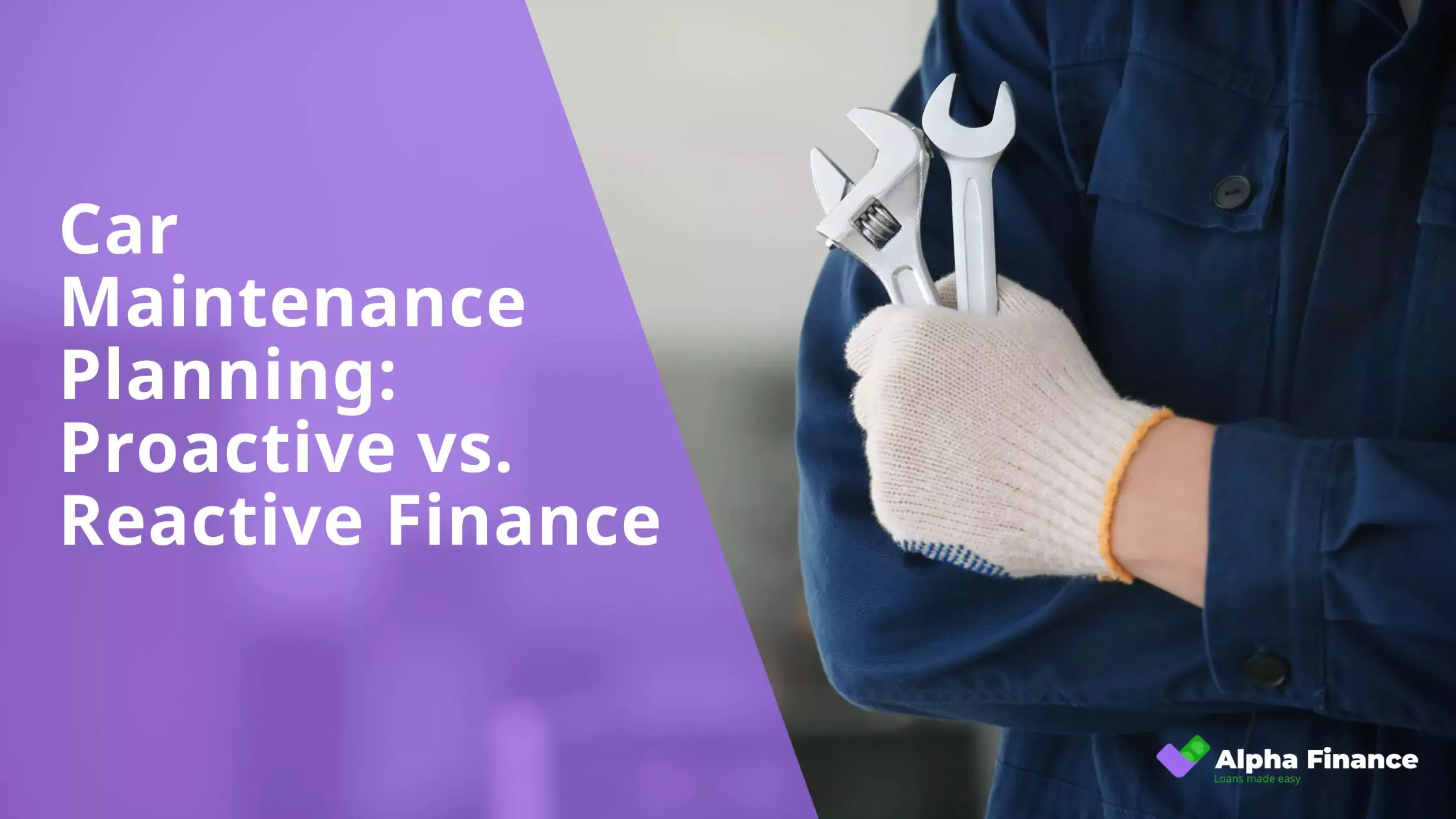Your car is humming along, getting you where you need to go, perhaps still under a manageable car financing arrangement. Then suddenly, a warning light flickers on the dashboard, you hear a strange new noise, or worse, there’s a complete breakdown that leaves you stranded. How you’ve prepared for that inevitable moment can mean the fundamental difference between a minor inconvenience and a major financial headache that throws your budget into disarray.
This scenario highlights a core dilemma in vehicle ownership: Should you adopt a proactive or reactive approach to car maintenance? While both methods ultimately deal with the costs of keeping your vehicle on the road, their financial implications, impact on reliability, and levels of associated stress couldn’t be more different. This blog post will delve into the benefits and strategies of both proactive and reactive financial planning for car maintenance. We’ll explore why one approach generally leads to significant long-term savings, greater vehicle reliability, and considerably less financial stress, ultimately advocating for a considered, forward-thinking mindset when it comes to your car’s upkeep.
Understanding Reactive Car Maintenance
Reactive car maintenance, often colloquially known as the “fix it when it’s broken” mentality, is an approach adopted by many drivers. While it might appear to save money in the immediate term by avoiding upfront costs, its financial and practical consequences almost always prove to be significantly more expensive and inconvenient in the long run.
-
Definition:
- Waiting for Failure: At its core, this strategy involves waiting until a specific car component completely breaks down, fails outright, or exhibits a severe and undeniable malfunction before any steps are taken to address the issue. Maintenance is never scheduled in advance; it’s always in response to a problem.
- Crisis-Driven Action: Repairs are exclusively undertaken out of necessity—when a problem directly impacts the car’s drivability, its safety, or prevents it from operating at all. There is no preventative action.
- “Fix It When It’s Broken”: This popular phrase perfectly encapsulates the reactive mindset, where the costs of regular servicing, minor repairs, or scheduled part replacements are deliberately avoided until an unavoidable and often critical issue forces an intervention.
-
Financial Implications (The Downsides):
- Significantly Higher Repair Costs: Reactive maintenance almost invariably leads to substantially more expensive repairs. A minor, unaddressed issue (e.g., a small oil leak from a seal, a slightly worn serpentine belt) can rapidly escalate into a catastrophic system failure (e.g., engine seizure due to lack of lubrication from the ignored leak, or complete loss of power steering and charging from a snapped belt). These major failures are inherently costlier to fix than the initial minor problem.
- Emergency Pricing & Limited Options: When your car breaks down unexpectedly, you’re typically in an emergency situation. This urgency leaves you with little to no time to shop around for competitive quotes from multiple mechanics. You are often forced to accept the immediate pricing from the nearest available repair shop or towing service, which might be higher due to the emergency nature of the work.
- Increased Reliance on Credit/Debt: Unexpected and often very large repair bills are a hallmark of reactive maintenance. Without a dedicated financial buffer, you’re far more likely to resort to high-interest credit cards, personal loans, or even short-term, expensive lines of credit to cover these immediate costs, leading to accumulated debt and further financial strain.
- Higher Towing/Roadside Assistance Costs: More frequent and severe breakdowns directly correlate with a higher reliance on towing services and roadside assistance memberships or call-out fees. These additional expenses accumulate over time and could have largely been avoided through preventative care.
- Accelerated Depreciation & Loss of Resale Value: A car that is only repaired when it completely fails, and lacks a documented history of regular, scheduled servicing, depreciates much faster. When it comes time to sell, it will be harder to find a buyer and will fetch a significantly lower price due to its perceived unreliability and lack of maintenance records.
-
Practical Downsides:
- Major Inconvenience and Disruption: The most immediate and tangible impact is the significant disruption to your daily life. This includes being stranded on the side of the road, needing to hastily arrange alternative transport for work, school drop-offs, or essential appointments, and losing valuable personal time dealing with the breakdown and repairs.
- Compromised Safety Risks: Driving with known or suspected mechanical issues that aren’t addressed promptly (e.g., worn brake pads, faulty lights, unusual engine noises, compromised steering components) severely compromises your vehicle’s safety. This significantly increases the risk of an accident for yourself, your passengers, and other road users.
- Heightened Stress and Anxiety: The sudden financial hit of an unexpected major repair, combined with the immense inconvenience, potential safety concerns, and the uncertainty of future breakdowns, generates considerable psychological stress and anxiety for the driver.
-
Who This Appeals To (and why it’s a trap):
- Misconceived Short-Term Savings: This approach often appeals to individuals who mistakenly believe they are saving money by avoiding the upfront costs of regular, scheduled servicing. They fail to account for the far greater, often unforeseen, expenses associated with emergency, catastrophic repairs that could have been prevented.
- Limited Immediate Cash Flow (The Backfire Effect): Individuals with very tight budgets or extremely limited immediate cash flow might feel compelled or forced into this reactive strategy. However, this invariably backfires, as small, affordable preventative costs are replaced by sudden, often unaffordable, emergency bills, frequently pushing them deeper into financial difficulty and debt. It’s a self-perpetuating cycle of financial instability.
The Power of Proactive Car Maintenance
In stark contrast to the reactive approach, proactive car maintenance fully embraces the timeless adage “prevention is better than cure.” It is a strategic, forward-thinking approach that consistently yields substantial dividends in terms of long-term financial savings, enhanced vehicle reliability, and unparalleled peace of mind.
-
Definition:
- Scheduled Upkeep: Proactive maintenance involves consistently adhering to a car’s manufacturer-recommended service schedule and diligently addressing any potential issues or signs of wear, even minor ones, before they have the opportunity to develop into major, costly problems or cause an unexpected breakdown.
- Forward-Thinking Approach: It is fundamentally a forward-looking strategy focused on preventing failures, optimising the vehicle’s performance and efficiency, and significantly extending its overall operational lifespan.
-
Key Pillars of Proactive Maintenance:
- Regular Servicing:
- Manufacturer’s Schedule Adherence: This is non-negotiable. Strict adherence to your car’s manufacturer-recommended service intervals (e.g., every 10,000 km or 12 months, whichever comes first, as specified in your owner’s manual). These schedules are meticulously designed to ensure critical components are maintained at optimal levels.
- Comprehensive Checks & Replacements: Regular services are not just oil changes. They involve essential tasks like oil changes, comprehensive fluid level checks and top-ups (including coolant, brake fluid, power steering fluid, transmission fluid), timely filter replacements (oil, air, cabin, fuel), tyre rotations, thorough brake inspections, and general multi-point vehicle health checks.
- Early Problem Detection: Crucially, regular servicing provides invaluable opportunities for experienced mechanics to identify early signs of wear and tear or potential mechanical issues (e.g., a slightly worn belt, a minor weeping seal, early signs of rust) long before they escalate into serious, financially draining failures.
- Routine Inspections (DIY & Professional):
- Empowering DIY Checks: Performing simple, routine checks yourself in between professional services can be highly effective and empowering. This includes:
- Regularly checking tyre pressure (vital for safety, fuel economy, and tyre lifespan) and tread depth (for grip and legality).
- Inspecting wiper blades for effectiveness and replacing them when they streak.
- Ensuring all exterior and interior lights are fully functional.
- Visually inspecting for any new fluid leaks under the car or unusual wear patterns on tyres.
- Supplementing Professional Care: These small, consistent checks act as an early warning system, supplementing the more in-depth professional services.
- Empowering DIY Checks: Performing simple, routine checks yourself in between professional services can be highly effective and empowering. This includes:
- Addressing Minor Issues Promptly:
- No Delaying: A core principle is to never ignore warning lights on your dashboard (e.g., “Check Engine,” “ABS,” “Oil Pressure”), strange new noises (like persistent squealing brakes, grinding sounds, or clunking from the suspension), or unusual smells (like burning oil, sweet coolant, or hot rubber).
- Preventing Cascading Damage: Investigating and replacing seemingly minor worn parts (e.g., a failing spark plug, a worn brake pad) before they completely fail is paramount. This actively prevents them from causing cascading, often catastrophic, damage to interconnected, more expensive systems (e.g., a misfiring spark plug damaging the catalytic converter; worn brake pads scoring the brake discs).
- Regular Servicing:
-
Financial Benefits (The Upsides):
- Significantly Reduced Overall Costs: This is the most compelling financial advantage. By preventing minor, relatively inexpensive repairs from escalating into highly expensive major ones, proactive maintenance drastically lowers your total car ownership costs over the long term. The labour and parts for preventative maintenance are almost invariably cheaper than emergency repairs.
- Predictable Expenses & Easier Budgeting: Regular servicing costs are known and predictable. This allows you to easily budget and save for them, integrating these expenses seamlessly into your monthly or annual financial plan. You’re never hit by unexpected, crippling bills.
- Improved Fuel Efficiency: A well-maintained car with clean filters, optimal fluid levels, correctly inflated tyres, and a properly tuned engine runs more efficiently. This directly translates to tangible savings on fuel costs over the long term.
- Extended Vehicle Lifespan: By consistently keeping all components in optimal working order, proactive maintenance dramatically extends your car’s operational lifespan, potentially delaying the need for a costly new vehicle purchase by several years.
- Higher Resale Value: A comprehensive and well-documented service history is an extremely powerful selling point when it comes to reselling your vehicle. It provides invaluable assurance to potential buyers regarding the car’s reliability and the care it has received, often enabling you to command a significantly higher resale price.
- Fewer Emergency Costs: The reduced likelihood of unexpected breakdowns directly translates to fewer instances of needing expensive towing services, emergency mechanic call-outs, or relying heavily on roadside assistance, saving you additional unplanned expenditure.
-
Practical Benefits:
- Enhanced Reliability: Your car consistently remains in good working order, making it far less likely to break down unexpectedly. This translates to dependable transport for your daily commute, family errands, and any travel plans.
- Superior Safety: With all critical components regularly inspected, maintained, and replaced when worn, your car operates at its safest capacity, significantly reducing the risk of accidents caused by mechanical failure.
- Unrivalled Peace of Mind: Knowing your vehicle is well-maintained, regularly checked, and thus less prone to sudden, unforeseen issues provides immense peace of mind. This significantly reduces the stress and anxiety typically associated with car ownership.
Financial Planning for Proactive Maintenance in Australia
Transitioning to a proactive approach to car maintenance isn’t just about scheduling services; it requires deliberate financial planning. For Australian drivers, integrating these costs into your budget is a smart move that yields long-term benefits.
-
Create a Dedicated “Car Maintenance” Budget Line Item:
- Allocate Monthly Funds: Even if your car only requires annual servicing, it’s savvy to divide the expected cost of that service by 12 and save that allocated amount monthly. This smooths out your expenses, preventing a large lump sum hit to your budget once a year.
- Research Expected Costs: Do your homework. Look up the average service costs for your specific make, model, and year of vehicle. Beyond basic servicing, factor in anticipated expenses for tyres (a significant cost typically every 3-5 years), annual registration, comprehensive insurance, and allocate a small emergency buffer for minor, unforeseen issues that might pop up between services.
- Separate from General Emergency Fund: Crucially, this dedicated maintenance budget is for expected upkeep and minor repairs. It should be separate from your general emergency fund, which is reserved for major unforeseen breakdowns or other life crises (as discussed in previous posts).
-
Set Up a Dedicated Savings Account:
- Sub-Account or Separate Account: Create a specific sub-account within your existing bank account or set up an entirely separate savings account purely for your car maintenance fund. Giving it a clear purpose helps prevent you from inadvertently spending the money.
- Automate Transfers: The “set and forget” method is highly effective. Set up regular automatic transfers from your transaction account into this dedicated savings account immediately after your pay comes in. This ensures consistent contributions without needing to remember manually.
-
Research Your Car’s Specific Needs:
- Adhere to Service Schedule: Strictly adhere to the manufacturer’s recommended service intervals. This is outlined in your car’s owner’s manual and is essential for optimal performance and longevity.
- Common Issues Awareness: Be proactive by researching common problems or known issues specific to your make and model. This awareness allows you to factor potential costs for these into your savings goal. For example, some models have specific parts that are known to fail around certain mileage marks.
- Tyre Replacement Cycle: Tyres are a significant expense that many drivers overlook in their budgeting. Depending on your driving habits and tyre type, budget for replacements every 3-5 years (or sooner). Factor this substantial cost into your long-term maintenance savings plan.
-
Consider Fixed-Price Servicing/Prepaid Plans:
- Predictable Costs: For new cars, many dealerships offer fixed-price servicing, which can make budgeting for routine maintenance very straightforward for the initial years of ownership.
- Prepaid Service Plans: Some manufacturers or dealerships also offer prepaid service plans that might provide a discount on overall servicing costs. Always read the fine print of these plans carefully to understand what’s included, any exclusions, and the terms if you sell the car.
-
Build a “Future Repairs” Buffer:
- Beyond Routine: Even with diligent proactive maintenance, major components can still unexpectedly fail (e.g., a transmission issue, a major engine repair). It’s smart to build a small additional buffer (e.g., contributing an extra $50-$100 per month) specifically for these larger, unforeseen repairs that go beyond routine servicing. This acts as a secondary safety net.
-
Find a Reputable Mechanic:
- Honest Advice: Establishing a relationship with a trusted, reputable mechanic is invaluable. A good mechanic will provide honest advice on necessary repairs versus merely recommended ones, helping you prioritise and budget effectively without unnecessary spending. Seek recommendations from friends, family, or online reviews.
Transitioning from Reactive to Proactive
If you’ve primarily adopted a reactive approach to car maintenance in the past, don’t worry – it’s never too late to transition to a proactive strategy. Even small steps can make a big difference.
-
Start Small:
- Schedule Overdue Service: Begin by scheduling any overdue services or addressing immediate, obvious issues your car might have. This is your first step towards getting ahead of problems.
- Modest Savings: Even if your budget is tight, start saving what you can, even if it’s just a small amount ($5-$10) each week or fortnight. Consistency is more important than the initial amount.
-
Prioritise Essential Maintenance:
- Safety First: If you’re overwhelmed, focus on safety-critical items first. Ensure your brakes are in good condition, tyres have adequate tread and pressure, steering and suspension are sound, and all lights are working correctly. These are non-negotiables for safe driving.
-
Educate Yourself:
- Basic Car Care Knowledge: Take the time to learn basic car care essentials. Understand what the common dashboard warning lights mean, how to check fluid levels, and the importance of tyre pressure. The more you know, the less likely you are to be caught off guard by minor issues or overcharged for simple fixes.
-
Utilise Budgeting Tools:
- Track and Plan: Employ budgeting apps or spreadsheets to track all your car-related expenses, from fuel to insurance and, crucially, your maintenance savings. Visualising your spending and savings progress can be highly motivating.
-
Be Patient:
- Long-Term Strategy: Building a substantial car maintenance fund and fully embracing a proactive mindset takes time and consistent effort. Don’t get discouraged if you don’t reach your savings goal immediately. The long-term peace of mind, financial savings, and reliability gained are absolutely worth the patience and discipline.
Conclusion
Ultimately, proactive car maintenance isn’t just about keeping your vehicle running smoothly; it’s a fundamental pillar of sound financial planning for any Australian driver. By embracing this forward-thinking approach, you’re not just preventing unexpected breakdowns; you’re actively saving money in the long run, drastically reducing financial stress, and ensuring the continued reliability and safety of your valuable asset. Don’t wait for a warning light on the dashboard or a complete breakdown to force you into creating a car maintenance budget. Embrace the proactive approach now and enjoy the smoother, more affordable ride that comes with being prepared.
Apply for a Car Loan Now!
Ready to get behind the wheel of your next car? Securing the right finance is often the first step. With competitive rates and flexible terms designed to suit a range of budgets, getting a car loan can be a straightforward process. Don’t put your dream car on hold. Apply for a car loan with Alpha Finance Australia today and discover how easy it is to drive away with confidence.




